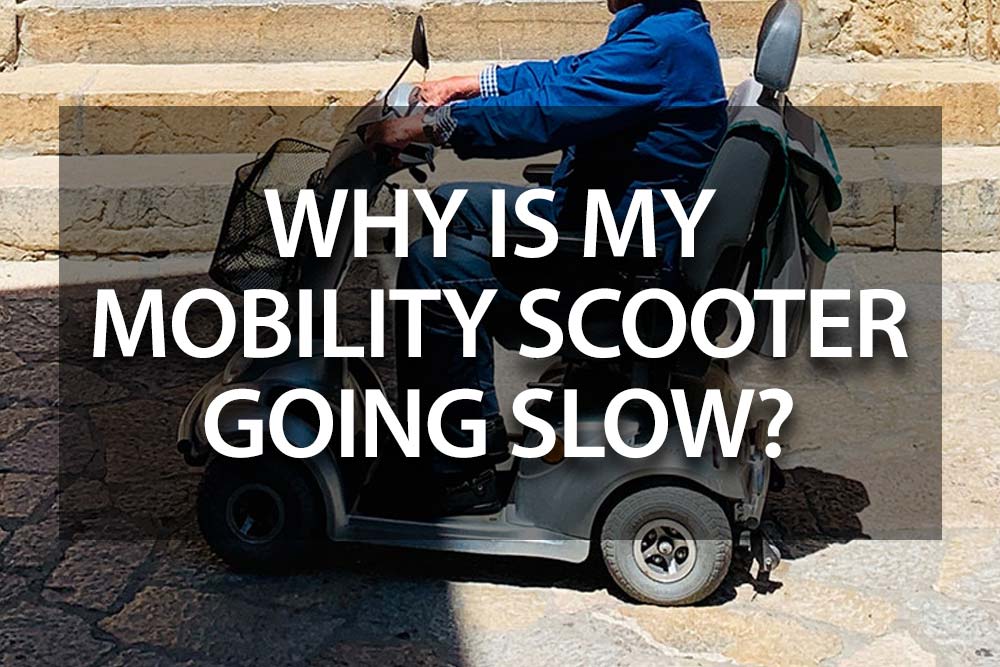It can be highly frustrating to find your mobility scooter is going slower than normal. Whenever a mobility scooter is not operating at full speed, the most common cause is usually the mobility scooter battery.
Battery
If you suspect that your scooter battery is failing, you can do some troubleshooting to find the cause. Firstly, the most obvious thing to check is whether or not your battery is fully charged. It can be easy to forget to charge the battery, but if you know that you have been charging it up, a loose wire could be a fault.
Take a close look at your battery and examine it for any damaged wires or loose connections that may be causing the problem. Sometimes a jolt from hitting a high curb or driving over a pothole can cause battery connections to become loose and not perform correctly.

Quality and reliable mobility scooter battery.
If you use your mobility scooter daily and your battery is very old, it could be time to replace it with a new one if you cannot locate another cause for its slow speed.
The wrong mode
Mobility scooters have mode settings, and it could be that your vehicle is set at the lowest power mode. On your scooter, this mode may be called ‘eco‘, beginner or the modes may be numbered, in which case the lowest power setting will be number one.
Being set in the lowest mode can mean your scooter runs at around five miles per hour at full throttle. You may notice that your scooter accelerates slowly up to this top speed, a feature to help new mobility scooter riders stay safe while they get used to using their vehicle.
It is easy to switch to beginner mode accidentally. It can be done when you mean to switch on your vehicle lights or other feature, depending on the layout of the controls. It is a common problem and one that can easily be fixed, so it is worth checking the mode setting on your scooter before you look for deeper issues.
Low tyre pressure
As your pneumatic mobility scooter tyres wear in, they become softer and will lose a fraction of their tyre pressure daily. While the tyres won’t be completely flat, the tyre pressure can fall low enough to affect speed and performance.
Low-pressured tyres can create a lot of resistance and drag, which will need more power to overcome. This means that pushing your scooter to reach its top-end speed can quickly drain your battery power, slowing down your scooter even more.
Double-check your tyre pressure before you use your scooter, especially if you don’t use it often. If you notice a tyre is deflating more quickly, it could have a slow leak which will need fixing.
Brake or wheel drag
Another common cause for slow running can be brake or wheel drag. A simple way to test this is to lift each wheel off the ground and turn it to see if it spins freely. Sometimes you may need to adjust the disc brakes to ensure the brake pads are set at the proper distance from the rotor.
Most mobility scooter models use mechanical discs that are not self-adjusting. They will need regular checking because, over time, the brake cables will stretch, causing the internal calliper springs to soften. This results in an unbalanced tension that can make a brake pad drag on the rotor.
Another common issue could be with your electromagnetic brakes. If you notice that your scooter stops when you lift the throttle, it can mean your brakes are engaging slightly, preventing you from reaching top speed.
Firmware update
Mobility scooters use firmware to tell the motor how to communicate with the scooter battery, brakes, throttle, lights, display and more. As with most software, the scooter firmware will need to be updated every so often to rid it of bugs that can cause issues, such as low speed or incorrect battery power level readings.
Firmware manufacturers run periodical updates to help boost performance, remedy issues and comply with country-specific speed limits. You may get a prompt to download a firmware patch or update, so it will pay you not to ignore these alerts.
Motor overheating
Overheating issues with your mobility scooter motor often happen during summer or when your scooter is being overworked. An overheated motor can cause your scooter to run slowly. It can help to keep your scooter within its daily limit and not push its boundaries by extra-long runs or overloading the scooter with too much weight.
Forcing an already overheated motor to keep going can risk an explosion, rendering your scooter unusable and landing you with an enormous repair bill. Turning off the scooter until the motor cools down is a priority to avoid expensive problems.
Other Problems
Sometimes the cause can be more technical, such as the throttle pot not working correctly. Throttle pot is short for the throttle potentiometer. To test this, you will need a voltmeter to measure the ohms. But if you don’t fancy doing this yourself, it is worth calling in a mobility scooter technical specialist to help you with this.
Other than the common causes mentioned above, there may be another reason for your mobility scooter running slow. It is worth having your vehicle checked over by a trained mobility scooter technician if you are worried that a mechanical fault may need rectifying.
Last update on 2024-05-02 / Affiliate links / Images from Amazon Product Advertising API

